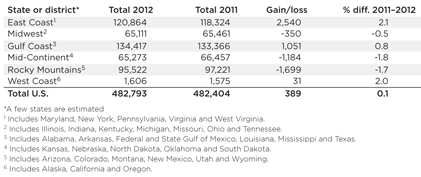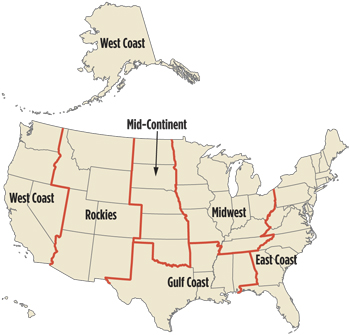2013 Forecast: Active gas well numbers increase slightly
The number of producing U.S. gas wells showed signs of growth in 2012, just barely reversing the negative trend of the previous year.
|
The number of producing U.S. gas wells showed signs of growth in 2012, just barely reversing the negative trend of the previous year. Producing wells were up 0.1% (389 wells), as compared to a 1.6% drop at the end of 2011. Even despite dismal gas prices, all states containing the Marcellus shale increased their numbers of producing gas wells. Ohio increased its producing well count 0.5% (up 173 wells), Pennsylvania rose 1.5% (up 789 wells) and West Virginia climbed 1.7% (up 827 wells). Pennsylvania featured the greatest number of producing gas wells, outside of Texas, in 2011, and retained that distinction in 2012. The Gulf Coast region increased its active gas well count by a cautious 0.8% or 1,051 wells. However, gas producing wells are up 6.2% (1,669 wells) in the Barnett shale. Districts 5 and 7B fell 1.4% and 4.4%, while District 9 posted the state’s greatest gas producer increase. District 9 grew by a not-so-modest 12.5% or 1,979 gas wells. Arkansas, which contains the gas-rich Fayetteville shale, saw a 1.8% producing increase (up 150 wells).
Both East and West Coast regions also grew, but at less impressive rates of 2.1% and 2.0%, respectively. New York added 676 wells which, while not the greatest increase in number of producing wells, is the greatest percentage growth in active gas wells on the East Coast (up 10.4%). West Virginia increased its gas producer count more than any state in the East Coast region, adding 827 onstream gas wells, and bringing the state above 50,000 producing wells. Midwest regional gas well production, which declined 4.7% in 2011 (the largest drop of any region) slowed its rate of descent last year, falling 0.5%. The Mid-Continent region decreased 1.8%, while the Rocky Mountain region fell 1.7%. The greatest percentage fall in gas producers, from any one state, was a 16.1% decrease in Nebraska. Following closely behind, Wyoming’s tally went down 15.2%, which translates to a remarkable loss of 3,984 producing gas wells. Despite a decline in CBM drilling, New Mexico’s producing gas well count went up a slight 0.5% (up 153 wells). Colorado also bucked the trend, gaining 1,899 producing gas wells in 2012, making it the largest increase in number of producing wells, outside of Texas District 9.
Not surprisingly, as gas prices continued to fall, with no recovery in sight, the Baker Hughes oil-to-gas drilling ratio average continued to shift toward oil and away from gas during 2012. The 2011 ratio average was 52.4% of rigs drilling for oil to 47.2% drilling for gas. Last year, this ratio widened to 70.8% of rigs drilling for oil and 29% of rigs drilling for gas. After hitting a yearly high of $3.77/Mcf in November, gas prices began to fall again and have been fluctuating below $3.50, since the start of the new year. The first few weeks of 2013 show a continued decrease in gas drilling, as the gap widened to 75% oil and 24.7% gas. |
|||||||||||||||||
- What's new in production (February 2024)
- Prices and governmental policies combine to stymie Canadian upstream growth (February 2024)
- U.S. operators reduce activity as crude prices plunge (February 2024)
- U.S. producing gas wells increase despite low prices (February 2024)
- U.S. drilling: More of the same expected (February 2024)
- U.S. oil and natural gas production hits record highs (February 2024)




